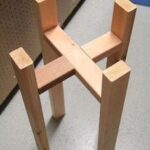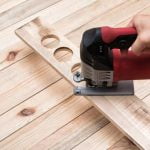Do you find yourself asking the question “how to stop dogs from chewing on woodwork“? Many dog owners have experienced the frustration of coming home to find their beloved pet has turned their new furniture or baseboards into a chew toy. In this article, we will explore the reasons why dogs engage in this behavior and provide practical tips and training techniques to help curb their wood-chewing habits.
It’s important for dog owners to understand why their furry friends are drawn to chewing on woodwork. By gaining insight into the underlying reasons for this behavior, you can better address the issue and prevent further damage to your home. Additionally, we will discuss the potential dangers of dogs chewing on woodwork, not only for your furniture but also for your pet’s health.
In addition to understanding the root causes of wood-chewing in dogs, we will also provide valuable tips for choosing the right chew toys for your pet. We will explore various training techniques that can effectively discourage wood-chewing behavior, as well as how positive reinforcement can be used to modify your dog’s habits.
Lastly, we will touch upon ways to protect your woodwork from your dog’s chewing and common mistakes to avoid when trying to stop this behavior.
The Potential Dangers of Dogs Chewing on Woodwork
Dogs chewing on woodwork can pose a potential danger to both the dog and your home. It is important to understand why dogs engage in this behavior and the potential consequences that may arise.
Some potential dangers of dogs chewing on woodwork include:
1. Injury to the dog: Chewing on hard surfaces like wood can cause splinters or sharp pieces to break off, leading to cuts or injuries in the dog’s mouth, gums, or throat.
2. Destruction of property: Wood-chewing can result in damage to furniture, door frames, baseboards, and other wooden fixtures in your home, leading to costly repairs or replacements.
3. Ingestion of toxic materials: Some wood treatments, paints, or finishes may contain harmful chemicals that can be ingested by the dog while chewing, leading to poisoning or other health issues.
To prevent these potential dangers and ensure the well-being of both your dog and your home, it is essential to take proactive measures to address wood-chewing behavior.
Ways to protect woodwork from your dog’s chewing:
– Apply bitter-tasting deterrents or pet-safe sprays on wooden surfaces.
– Use physical barriers such as baby gates or pet barriers to restrict access to areas with woodwork.
– Provide alternative chew toys and interactive puzzles for mental stimulation.
Understanding the potential dangers of dogs chewing on woodwork is crucial in addressing this behavior effectively. By implementing preventive measures and providing suitable alternatives for your dog, you can minimize the risks associated with wood-chewing while promoting a safe and healthy environment for your pet.
Tips for Choosing the Right Chew Toys for Your Dog
Understanding the importance of choosing the right chew toys for your dog is crucial when trying to stop them from chewing on woodwork. One key factor to consider is the size and sturdiness of the toy.
It is important to choose a chew toy that is appropriately sized for your dog, ensuring that it is not too small or too large for them to safely enjoy. Additionally, selecting a durable chew toy, such as those made of rubber or nylon, can help redirect their chewing behavior away from woodwork.
Another aspect to consider when choosing chew toys for your dog is their preferences and needs. Some dogs may prefer soft toys, while others may enjoy harder textures that provide more resistance. Understanding your dog’s preferences can help in selecting the right chew toys that will keep them engaged and satisfied, ultimately preventing them from turning to woodwork for chewing.
Lastly, it is essential to rotate and introduce new chew toys regularly to keep your dog entertained and prevent boredom-induced wood-chewing behaviors. Introducing a variety of textures and flavors can also pique their interest in their designated chew toys, making them less likely to seek out woodwork for chewing.
| Choosing Chew Toys | Considerations |
|---|---|
| Size and sturdiness | Appropriately sized and durable materials |
| Preferences and needs | Understanding dog’s preferences for texture and resistance |
| Variety and rotation | Regularly introducing new textures and flavors in chew toys |
Training Techniques to Discourage Wood-Chewing Behavior
Redirecting Behavior
One effective training technique to discourage wood-chewing behavior in dogs is redirection. When you catch your dog attempting to chew on woodwork, firmly say “no” and immediately redirect their attention to an appropriate chew toy. It’s important to make the chew toy more appealing than the woodwork by using toys with different textures, flavors, and shapes. This will help satisfy your dog’s natural chewing instincts in a positive way.
Consistent Discipline
Consistency is key when training your dog not to chew on woodwork. Ensure that everyone in the household is on the same page and uses the same verbal cues and redirection techniques. Dogs thrive on consistency and routine, so be patient and persistent with your training efforts. Avoid yelling or physical punishment as this can confuse and frighten your dog, making the behavior worse.
Supervision and Management
Another important training technique is supervision and management. If you’re unable to supervise your dog, confine them to a safe area or use baby gates to block access to specific areas where woodwork may be found. This way, you can prevent unwanted chewing behavior when you’re not able to provide direct supervision.
The key takeaway from these training techniques is that consistency, patience, and positive reinforcement are essential in effectively stopping dogs from chewing on woodwork. By implementing these strategies, you can help your furry friend develop healthier chewing habits while also preserving your home’s woodwork.
Using Positive Reinforcement to Stop Wood-Chewing
When it comes to stopping your dog from chewing on woodwork, positive reinforcement can be a valuable tool. This training technique focuses on rewarding your dog for good behavior rather than punishing them for undesirable behavior. By using positive reinforcement, you can effectively communicate to your dog what is and isn’t acceptable when it comes to chewing.
Here are some effective ways to use positive reinforcement to stop wood-chewing:
- Provide plenty of chew toys: Make sure your dog has access to a variety of safe and durable chew toys. When you catch your dog chewing on an appropriate toy instead of woodwork, be sure to praise and reward them.
- Use treats as rewards: Whenever you observe your dog avoiding woodwork or choosing a chew toy instead, offer them a tasty treat as a reward. This will reinforce the good behavior and encourage them to continue making the right choice.
- Offer verbal praise: In addition to treats, verbal praise such as “good job” or “good boy/girl” can also serve as positive reinforcement. Dogs respond well to positive attention from their owners, so be sure to lavish them with praise when they make the right choices.
By using positive reinforcement techniques consistently, you can effectively teach your dog what is appropriate when it comes to chewing behaviors, ultimately helping them break the habit of chewing on woodwork.
Remember that consistency is key when using positive reinforcement. It’s important to always reward and praise your dog for choosing chew toys over woodwork, while also avoiding inadvertently reinforcing negative behaviors. With patience and dedication, you can effectively use positive reinforcement to stop dogs from chewing on woodwork.
Ways to Protect Woodwork From Your Dog’s Chewing
Dogs chewing on woodwork can be a common problem for many pet owners. While it may seem like a harmless habit, it can lead to potential dangers for your dog and damage to your home. Understanding why dogs chew on woodwork is the first step in finding ways to protect your home from this behavior.
One of the main reasons dogs chew on woodwork is due to boredom or anxiety. Providing your dog with enough physical exercise and mental stimulation can help prevent this behavior. Additionally, ensuring that your dog has access to appropriate chew toys and bones can also deter them from chewing on woodwork.
When choosing chew toys for your dog, it’s important to select ones that are safe and durable. Look for toys that are specifically designed for heavy chewers and are made of materials that won’t splinter or break apart easily. Avoid toys that resemble household items or have components that could be mistaken for woodwork, as this could confuse your dog.
In addition to providing appropriate chew toys, it’s essential to implement training techniques to discourage wood-chewing behavior. Using positive reinforcement, such as praise and treats, when your dog shows interest in their toys instead of the woodwork can help reinforce good habits.
| Reasons for Wood-Chewing | Preventive Measures |
|---|---|
| Boredom or Anxiety | Provide physical exercise and mental stimulation |
| Lack of Appropriate Chew Toys | Select safe and durable chew toys specifically designed for heavy chewers |
| Inadequate Training Techniques | Use positive reinforcement when redirecting chewing behavior towards appropriate toys |
Common Mistakes to Avoid When Trying to Stop Wood-Chewing
One common mistake that dog owners make when trying to stop their dogs from chewing on woodwork is using punishment as a deterrent. It’s important to remember that dogs don’t respond well to punishment and it can actually make the behavior worse. Instead of scolding or punishing your dog for chewing on woodwork, it’s best to focus on positive reinforcement and redirecting their behavior.
Another mistake to avoid is not providing enough mental and physical stimulation for your dog. Dogs often chew out of boredom or excess energy, so it’s important to make sure they are getting enough exercise and mental enrichment. This can help decrease their desire to chew on woodwork and instead focus their energy on more appropriate activities.
Additionally, some dog owners make the mistake of not seeking professional help when dealing with persistent wood-chewing behaviors. If you have tried various techniques and your dog continues to chew on woodwork, it may be time to seek help from a professional trainer or behaviorist. They can assess the situation and provide personalized guidance on how to stop your dog from chewing on woodwork.
Seeking Professional Help for Persistent Wood-Chewing Behaviors
In conclusion, understanding why dogs chew on woodwork is essential in preventing this behavior. It’s important to recognize that dogs may chew on woodwork due to boredom, anxiety, teething, or simply out of habit. Identifying the underlying cause will help in addressing the problem effectively.
The potential dangers of dogs chewing on woodwork cannot be overstated. Not only can it cause damage to your home, but it can also pose health risks to your dog if they ingest splinters or toxic substances from treated wood. This is why finding the right chew toys for your dog is crucial. Look for durable and safe toys that are specifically designed for heavy chewers.
Training techniques and positive reinforcement are powerful tools in stopping wood-chewing behaviors. Consistent training, along with rewarding good behavior, can help your dog understand what is acceptable to chew on and what is not. Additionally, protecting woodwork from your dog’s chewing by using deterrent sprays or barriers can be effective in redirecting their attention away from the wood.
If despite all efforts, your dog’s wood-chewing behavior persists, seeking professional help from a veterinarian or animal behaviorist is advisable to address any underlying issues causing this behavior. By being proactive and patient, you can effectively stop dogs from chewing on woodwork and provide a safe environment for both your pet and your home.
Frequently Asked Questions
What Can I Put on Wood So My Dog Stops Chewing It?
There are several options to deter dogs from chewing wood. You can use bitter apple spray, vinegar, or citrus sprays as a deterrent. Additionally, providing your dog with appropriate chew toys and regular exercise can also help curb their desire to chew on wood.
Does Vinegar Stop Dogs From Chewing Wood?
Vinegar can be effective in stopping dogs from chewing wood. You can create a mixture of equal parts white vinegar and water and spray it onto the wood surfaces that your dog likes to chew. The strong smell and taste of vinegar often deters dogs from chewing.
What Repels Dogs From Chewing?
There are several things that can repel dogs from chewing, aside from vinegar. Bitter apple spray, citrus sprays, and cayenne pepper can all be effective deterrents. Additionally, offering appropriate chew toys, ensuring regular exercise, and providing mental stimulation can also help prevent dogs from chewing on inappropriate items like wood.

Hi everyone! I’m a woodworker and blogger, and this is my woodworking blog. In my blog, I share tips and tricks for woodworkers of all skill levels, as well as project ideas that you can try yourself.





